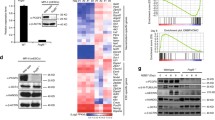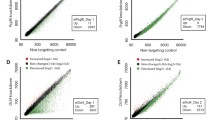Abstract
Polycomb-group (PcG) proteins maintain transcriptional silencing through specific histone modification and are essential for cell-fate transition and proper development of embryonic and adult stem cells. Recent advances in molecular analysis of PcG proteins have revealed that the distinct subunit composition of PRC1 confers specific and nonoverlapping functions for regulation of embryonic and adult stem cells. Here, we provide an overview of recent findings regarding the role of PcG proteins in cardiac development, with focus on the diversity of PcG complexes.
You have full access to this open access chapter, Download chapter PDF
Similar content being viewed by others
Keywords
1 Introduction
Cardiac development is a complex and ordered process that requires cellular specification, proliferation, and differentiation, as well as further migration of cell populations from diverse sites. The primary heart field (PHF) originates in the anterior splanchnic mesoderm, then gives rise first to the cardiac crescent, later to the linear heart tube, and ultimately contributes to parts of the left ventricular (LV) region. The second cardiogenic region, known as the second heart field (SHF), lies in the anterior, posterior, and dorsal to the linear heart tube and is derived from the pharyngeal mesoderm located medial and anterior to the cardiac crescent. Cells from the SHF are added to the developing heart tube and give rise to the outflow tract (OFT), right ventricular (RV) region, and main parts of atrial tissues [1].
Congenital heart defects (CHDs) represent the most common anomaly seen in human newborns, with a prevalence of approximately 1 % of all births [1]. Traditionally, focus on causes of CHD has involved transcriptional networks during cardiogenesis, because correct alignment and septation of cardiac structures regulated by cardiac specific transcriptional factors, such as Tbx1 , Tbx5 , Tbx20, Gata4, and Nkx2-5 , are essential for cardiac morphogenesis [1]. In addition to these multiple genetic factors, recent studies have shown that some chromatin remodeling factors moderate gene expression to control cardiogenesis and are also involved in the molecular pathogenesis of CHD [2–7].
Polycomb-group (PcG) proteins maintain transcriptional silencing by regulating chromatin configuration [8, 9]. There are two principal PcG repressive complexes (PRCs), PRC1 and PRC2. Mammalian PRC2 contains four core proteins (Ezh1/2, Eed, Suz12, Rbbp4/7) and trimethylates histone H3 at lysine 23 (H3K27), while the other complex, PRC1, consists of a combination of several protein families, including chromobox (Cbx), Ring, polyhomeotic (Ph), and posterior sex combs (Psc), and induces mono-ubiquitination of histone H2A at lysine 119 (Fig. 43.1). In recent studies, PRC1 have been divided to Cbx-PRC1 (canonical PRC1) and Rybp-PRC1 (noncanonical PRC1) [10, 11]. Since development of high-throughput techniques for analyzing the genome in the past decade, PcG-mediated transcriptional repression has resulted in increased molecular information regarding its role in a number of important biological activities such as cell cycle progression, differentiation, and cell-fate transition in multiple cell types and tissue contexts, including embryonic, adult, and cancer stem cells. This PcG-mediated transcriptional repression can vary during development and among cell types. However, the precise role in the context of cell conditions remains unclear.
2 PcG Functions in Cardiac Development
In this review, we primarily focused on the functions of PcG proteins in cardiac development. Their roles have been elucidated via generation of knockout (KO) mice for each of the PcG components. Among the PRC2 components, loss of Suz12, Ezh2, or Eed results in embryonic lethality during the early postimplantation stage [12–14]. To address the role of PRC2 in cardiac development, Ezh2 and Eed were conditionally inactivated in specified cardiac cells using Nkx2-5:Cre or TnT:Cre [3, 4]. Inactivation of Ezh2 by Nkx2-5:Cre (Ezh2NK) and Eed by TnT:Cre (EedTnT) led to embryonic lethality and several cardiac defects including compact myocardial hypoplasia, whereas inactivation of Ezh2 by TnT:Cre (Ezh2TnT) did not result in severe defects in cardiogenesis despite a modest upregulation of some cardiac genes, probably because of the redundant functions of Ezh1 and Ezh2.
Embryos deficient of Ring1b, a core component of PRC1, also displayed early embryonic lethality caused by gastrulation arrest [15]. Although early developmental arrest in Ring1b KO embryos was partially restored by inactivation of Cdkn2a (Ink4a/ARF), cardiac tissue did not develop in double-KO embryos. Unlike early developmental defects seen in KO mice lacking some of the core PRC1 and PRC2 components, deficiency of other components has been shown to give rise to restricted effects. For example, loss of Rae28/Phc1 resulted in perinatal lethality with cardiac anomalies, double outlet right ventricle, and tetralogy of Fallot [6, 7]. In addition to cardiac defects, Rae28/Phc1 deficient mice also showed craniofacial developmental defects, as well as thymus and parathyroid gland defects as seen in human DiGeorge syndrome.
Among Cbx proteins, Cbx4 may play an important role in cardiogenesis. SUMO-specific protease 2 (SENP2) was reported to regulate transcription of Gata4 and Gata6 , mainly through alteration of the occupancy of Cbx4 on their promoters [5]. In SENP2-deficient embryos, sumoylated Cbx4 accumulates on the promoters of target genes, leading to transcriptional repression of Gata4 and Gata6. Furthermore, Cbx4 mutant mice displayed postnatal lethality with severe hypoplasia of the developing thymus as a result of reduced thymocyte proliferation. However, the function of Cbx4 in cardiogenesis has not been clearly elucidated [16]. Thus, PcG proteins are essential for molecular regulation of the expression of several cardiac genes during embryogenesis and important for cardiac morphogenesis.
3 Diversity of PcG Proteins
In our recent studies, expression of the PRC1 components Ring1b, Bmi1/Pcgf4, and Rae28/Phc1 was detected in embryonic hearts containing both the PHF and SHF embryonic cardiac fields (Fig. 43.2), though their expression patterns were not restricted in cardiac cells. Despite the ubiquitous expression of PRC1 components, mice with single PcG KO except for the core proteins show more distinct and restricted phenotypes. Among Psc proteins, genetic deletion of Mel18/Pcgf2 or Bmi1/Pcgf4 resulted in postnatal lethality caused defects in anterior-posterior specification, while there was no effect on cardiogenesis [17, 18]. Also, Mel18/Bmi1 double-KO mice died around E9.5 and exhibited more severe developmental defects than those with KO of either alone, suggesting that Mel18/Pcgf2 and Bmi1/Pcgf4 have partially redundant functions [18]. In addition to functional redundancy, recent studies have shown that distinct Cbx and Pcgf proteins confer specific and nonoverlapping functions of PRC1 in embryonic and adult stem cells [10, 11]. Exchanging Cbx protein in canonical PRC1 is involved in the switch from self-renewal to a differentiation state, whereas Pcgf and other noncanonical components, such as Rybp, Kdm2b, and L3mbtl2, also confer restricted functions to PRC1.
4 Pcgf5 Expression in the Developing Heart
Recently, we identified Pcgf5 as an upregulated gene during cardiomyocyte differentiation of ES cells as well as strong expression of Pcgf5 in cardiac fields during the early embryonic stages as compared to other embryonic tissues [19] (Fig. 43.3). Unlike Bmi1/Pcgf4, Pcgf5 expression, patterns were more restricted to early mouse embryos. Our hypothesis states that exchanging Pcgf components within PRC1 determines the specificity of their function in the developing heart.
5 Conclusions
Recent increasing evidence obtained in experiments with embryonic and adult stem cells indicates that the diversity of PRC components, particularly PRC1, contributes to specification of their function (Fig. 43.4). Furthermore, transcriptional repression by PcG is essential for cardiogenesis. Understanding PcG functions and more detailed characterization of the PcG complex during cardiogenesis may be crucial for elucidating the molecular mechanisms regulating cardiac development.
References
Buckingham M, Meilhac S, Zaffran S. Building the mammalian heart from two sources of myocardial cells. Nat Rev Genet. 2005;6:826–35. doi:10.1038/nrg1710.
Hang CT, Yang J, Han P, et al. Chromatin regulation by Brg1 underlies heart muscle development and disease. Nature. 2010;466:62–7. doi:10.1038/nature09130.
Delgado-Olguin P, Huang Y, Li X, et al. Epigenetic repression of cardiac progenitor gene expression by Ezh2 is required for postnatal cardiac homeostasis. Nat Genet. 2012;44:343–7. doi:10.1038/ng.1068.
He A, Ma Q, Cao J, et al. Polycomb repressive complex 2 regulates normal development of the mouse heart. Circ Res. 2012;110:406–15. doi:10.1161/CIRCRESAHA.111.252205.
Kang X, Qi Y, Zuo Y, et al. SUMO-specific protease 2 is essential for suppression of polycomb group protein-mediated gene silencing during embryonic development. Mol Cell. 2010;38:191–201. doi:10.1016/j.molcel.2010.03.005.
Shirai M, Osugi T, Koga H, et al. The polycomb-group gene Rae28 sustains Nkx2.5/Csx expression and is essential for cardiac morphogenesis. J Clin Invest. 2002;110:177–84. doi:10.1172/JCI14839.
Takihara Y, Tomotsune D, Shirai M, et al. Targeted disruption of the mouse homologue of the drosophila polyhomeotic gene leads to altered anteroposterior patterning and neural crest defects. Development. 1997;124:3673–82.
Aloia L, Di Stefano B, Di Croce L. Polycomb complexes in stem cells and embryonic development. Development. 2013;140:2525–34. doi:10.1242/dev.091553.
Schwartz YB, Pirrotta V. A new world of polycombs: unexpected partnerships and emerging functions. Nat Rev Genet. 2013;14:853–64. doi:10.1038/nrg3603.
Gao Z, Zhang J, Bonasio R, et al. PCGF homologs, CBX proteins, and RYBP define functionally distinct PRC1 family complexes. Mol Cell. 2012;45:344–56. doi:10.1016/j.molcel.2012.01.002.
Morey L, Pascual G, Cozzuto L, et al. Nonoverlapping functions of the polycomb group Cbx family of proteins in embryonic stem cells. Cell Stem Cell. 2012;10:47–62. doi:10.1016/j.stem.2011.12.006.
Faust C, Schumacher A, Holdener B, Magnuson T. The eed mutation disrupts anterior mesoderm production in mice. Development. 1995;121:273–85.
O’Carroll D, Erhardt S, Pagani M, et al. The polycomb-group gene Ezh2 is required for early mouse development. Mol Cell Biol. 2001;21:4330–6. doi:10.1128/MCB.21.13.4330-4336.2001.
Pasini D, Bracken AP, Jensen MR, et al. Suz12 is essential for mouse development and for EZH2 histone methyltransferase activity. EMBO J. 2004;23:4061–71. doi:10.1038/sj.emboj.7600402.
Voncken JW, Roelen BAJ, Roefs M, et al. Rnf2 (Ring1b) deficiency causes gastrulation arrest and cell cycle inhibition. Proc Natl Acad Sci U S A. 2003;100:2468–73. doi:10.1073/pnas.0434312100.
Liu B, Liu Y-F, Du Y-R, et al. Cbx4 regulates the proliferation of thymic epithelial cells and thymus function. Development. 2013;140:780–8. doi:10.1242/dev.085035.
van der Lugt NM, Domen J, Linders K, et al. Posterior transformation, neurological abnormalities, and severe hematopoietic defects in mice with a targeted deletion of the bmi-1 proto-oncogene. Genes Dev. 1994;8:757–69. doi:10.1101/gad.8.7.757.
Akasaka T, van Lohuizen M, van der Lugt N, et al. Mice doubly deficient for the polycomb group genes Mel18 and Bmi1 reveal synergy and requirement for maintenance but not initiation of Hox gene expression. Development. 2001;128:1587–97.
Narumiya H, Hidaka K, Shirai M, et al. Endocardiogenesis in embryoid bodies: novel markers identified by gene expression profiling. Biochem Biophys Res Commun. 2007;357:896–902. doi:10.1016/j.bbrc.2007.04.030.
Acknowledgments
This work was supported by a JSPS KAKENHI Grant (24591595).
Author information
Authors and Affiliations
Corresponding author
Editor information
Editors and Affiliations
Rights and permissions
Open Access This chapter is distributed under the terms of the Creative Commons Attribution-Noncommercial 2.5 License (http://creativecommons.org/licenses/by-nc/2.5/), which permits any noncommercial use, distribution, and reproduction in any medium, provided the original author(s) and source are credited. The images or other third party material in this chapter are included in the work's Creative Commons license, unless indicated otherwise in the credit line; if such material is not included in the work's Creative Commons license and the respective action is not permitted by statutory regulation, users will need to obtain permission from the license holder to duplicate, adapt or reproduce the material.
Copyright information
© 2016 The Author(s)
About this chapter
Cite this chapter
Shirai, M., Takihara, Y., Morisaki, T. (2016). Pcgf5 Contributes to PRC1 (Polycomb Repressive Complex 1) in Developing Cardiac Cells. In: Nakanishi, T., Markwald, R., Baldwin, H., Keller, B., Srivastava, D., Yamagishi, H. (eds) Etiology and Morphogenesis of Congenital Heart Disease. Springer, Tokyo. https://doi.org/10.1007/978-4-431-54628-3_43
Download citation
DOI: https://doi.org/10.1007/978-4-431-54628-3_43
Published:
Publisher Name: Springer, Tokyo
Print ISBN: 978-4-431-54627-6
Online ISBN: 978-4-431-54628-3
eBook Packages: MedicineMedicine (R0)








